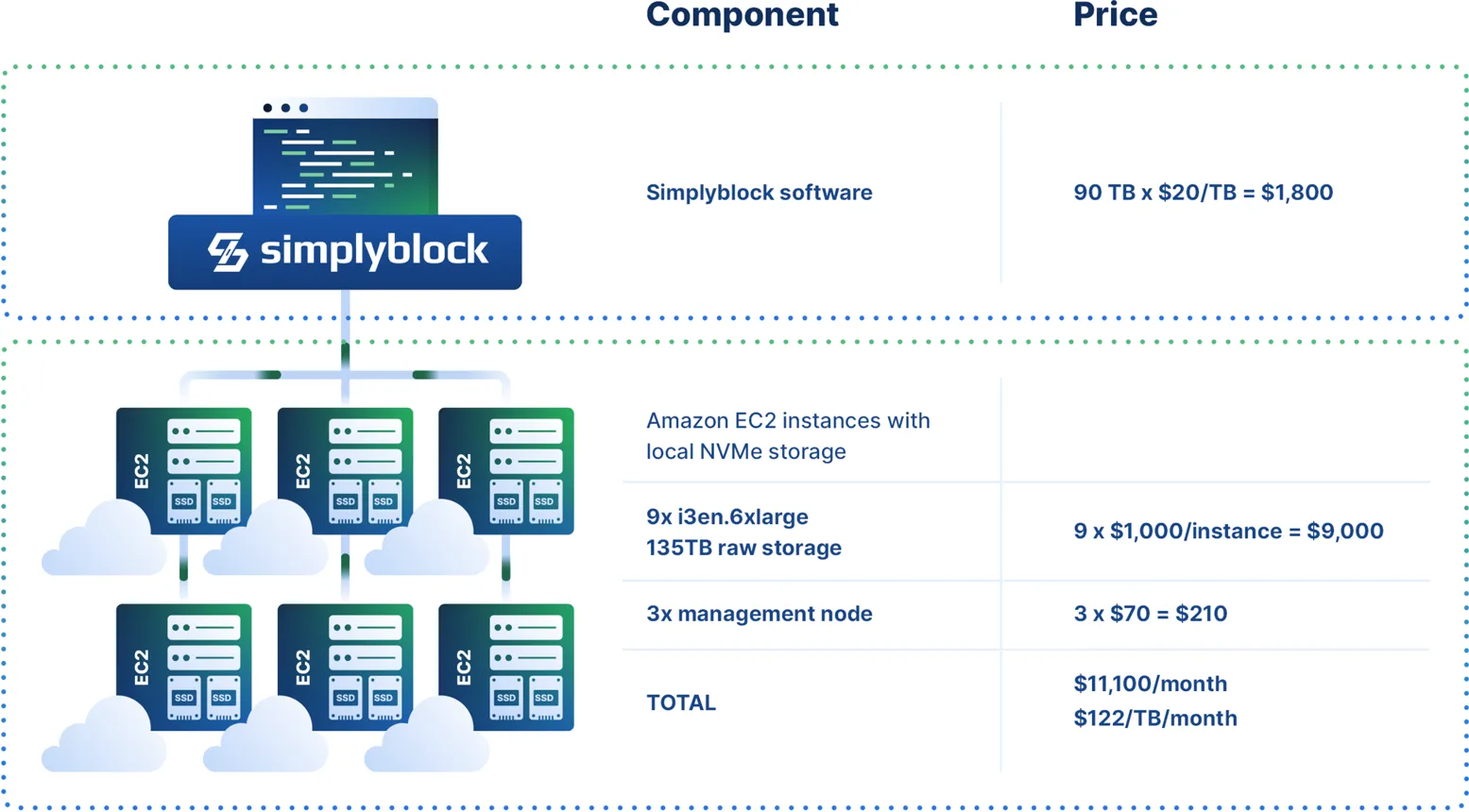Take Full Control of Your Storage.
At simplyblock we believe in simple, predictable pricing.
All prices are calculated based on the total provisioned storage on logical volume level.

Free
Deploy and manage simplyblock yourself
$0FREE FOREVER
Deploy NowFeatures
- Self-operated
- Community support
- Enterprise-grade features (see comparison table below)
Recommended
Bring Your Own Infrastructure
Deployed on-prem or into your cloud account
$10-20per TB/month
Talk to an ExpertFeatures
- Installation on your infrastructure
- Slack and email support by simplyblock
- Technical Account Manager
- All features (see comparison table below)
Enterprise
Simplyblock the way you want it
Contact us to discuss your setup
Talk to an ExpertFeatures
- Installation on your infrastructure
- Premium Support and SLAs according to your needs
- Dedicated Technical Account Manager
- All features (see comparison table below)
Simplyblock Feature Comparison
| Free | Bring Your Own Infrastructure | Enterprise | |
|---|---|---|---|
| Key Highlights | |||
Managed by SimplyblockSimplyblock operates your storage cluster |
|
| |
All Core FeaturesAre all core features available |
|
| |
Multi TenantYou can share the storage cluster between multiple tenants |
|
| |
Deployed in your Cloud AccountThe storage cluster is installed into your own cloud account |
|
|
|
Support TierWhat level of support is included in the subscription | Community | Premium | Dedicated |
PricingWhat is the pricing model | Free | Commercial | Commercial |
| Features | |||
Copy-On-Write VolumesCopy-on-write (COW) is an optimization technique used in computer programming and data management |
|
|
|
NVMe/TCP VolumesHigh-performance storage devices that use the NVMe over standard TCP/IP networks |
|
|
|
Data DistributionData distribution is the process of spreading data across multiple storage nodes to improve performance, reliability, and scalability of a storage system |
|
|
|
Storage OvercommitmentStorage overcommitment is allocating more virtual storage capacity to users than is physically available, relying on typical underutilization of provisioned resources |
|
|
|
Thin ProvisioningThin provisioning allows creating logical volumes larger than available physical storage, allocating actual space only when data is written |
|
|
|
Instant SnapshotsInstant snapshots are point-in-time copies of data created instantly without duplicating the entire dataset, using copy-on-write technology |
|
|
|
Local ClonesLocal clones are instant, space-efficient copies of volumes that share data with the original until modifications occur, enabled by copy-on-write technology |
|
|
|
Remote ClonesRemote clones are copy-on-write replicas of data volumes created and stored in a different location from the original source |
|
| |
DeduplicationDeduplication is a data compression technique that eliminates duplicate copies of repeating data to improve storage efficiency and reduce costs |
|
| |
CompressionCompression is a technique that reduces data size by encoding information more efficiently, saving storage space and potentially improving transfer speeds |
|
|
|
EncryptionEncryption prevents unauthorized access to data, enabling individual encryption keys per volume |
|
|
|
Cluster ReplicationCluster replication is the synchronization of data across multiple storage nodes to ensure high availability and fault tolerance |
|
| |
Online ResizingOnline resizing allows storage volumes to be expanded or shrunk without disrupting service, while simplyblock remains operational and accessible |
|
|
|
Zero Downtime ScalabilityZero downtime scalability allows simplyblock to expand capacity or performance without interrupting service, ensuring continuous availability during growth or increased demand |
|
|
|
High AvailabilityHigh availability is a system design approach that ensures simplyblock remains operational and accessible with minimal downtime or interruptions |
|
|
|
Disaster RecoveryDisaster recovery is a set of strategies and tools to quickly restore IT systems and data after a catastrophic event or major failure |
|
| |
QoS PolicyQoS policy defines rules to manage volume traffic priorities, IOPS, and throughput, ensuring critical data flows receive necessary resources while limiting less important traffic |
|
| |
Management UIThe management UI is a graphical interface for administrators to monitor, configure, and control simplyblock's storage resources and operations |
|
| |
Provisioned CapacityProvisioned capacity is the total storage space allocated to volumes in the storage cluster, regardless of how much is actually being used | < 100TB | Unlimited | Unlimited |
Multi AttachMulti-attach allows a single storage volume to be connected to multiple compute instances simultaneously, improving availability and resource utilization |
|
| |
| Get Started | Talk to an Expert | Get a Quote | |
Free
Bring Your Own Infrastructure
Enterprise
Free
Bring Your Own Infrastructure
Enterprise
Free
Bring Your Own Infrastructure
Enterprise
Free
Bring Your Own Infrastructure
Enterprise
Free
Community
Bring Your Own Infrastructure
Premium
Enterprise
Dedicated
Free
Free
Bring Your Own Infrastructure
Commercial
Enterprise
Commercial
Free
Bring Your Own Infrastructure
Enterprise
Free
Bring Your Own Infrastructure
Enterprise
Free
Bring Your Own Infrastructure
Enterprise
Free
Bring Your Own Infrastructure
Enterprise
Free
Bring Your Own Infrastructure
Enterprise
Free
Bring Your Own Infrastructure
Enterprise
Free
Bring Your Own Infrastructure
Enterprise
Free
Bring Your Own Infrastructure
Enterprise
Free
Bring Your Own Infrastructure
Enterprise
Free
Bring Your Own Infrastructure
Enterprise
Free
Bring Your Own Infrastructure
Enterprise
Free
Bring Your Own Infrastructure
Enterprise
Free
Bring Your Own Infrastructure
Enterprise
Free
Bring Your Own Infrastructure
Enterprise
Free
Bring Your Own Infrastructure
Enterprise
Free
Bring Your Own Infrastructure
Enterprise
Free
Bring Your Own Infrastructure
Enterprise
Free
Bring Your Own Infrastructure
Enterprise
Free
< 100TB
Bring Your Own Infrastructure
Unlimited
Enterprise
Unlimited
Free
Bring Your Own Infrastructure
Enterprise
Learn more about your options
Simplyblock for AWS Calculator
Try our cost calculator and get an estimate of how much can you save on your AWS storage with simplyblock. It takes just 30 seconds to get an estimate!
Questions about sizing or pricing
Are you unsure about simplyblock pricing, potential sizing of your cluster or how do we derive savings estimates? Get on a call with one of our experts, without any commitment.
Reduce your storage costs with simplyblock
In this example we assume:
Storage demand: 150TB of provisioned logical capacity
Physical storage: With erasure coding and thin provisioning only 75TB of physical disk space is required.
Component
Price
Simplyblock License Costs
150 TB x $20/TB = $3,000/month
Data Center Costs
Hardware
(Servers, NVMe Drives)
Power & Other
Average Storage Cost (150TB)
$1,250/month
$1,750/month
$6,000/month
$40/TB/month


Frequently Asked Questions
-Thin provisioning: Only pay for the storage you actually use, not what you provision.
-Storage tiering: Automatically move infrequently accessed data to cheaper storage tiers like Amazon S3.
-Pooling of EBS volumes: Consolidate partially used volumes into a shared pool, increasing utilization.
-Compression: Reduce the amount of physical storage needed.
-Deduplication: Eliminate redundant data across volumes.
-Multi-attach capability: Use a single volume for high-availability setups instead of replicating data.
By leveraging these capabilities, many customers see cost reductions of 75% or more compared to their previous Amazon EBS spend.
-Intelligent storage optimization and orchestration
-Automatic tiering between fast and slow storage
-Thin provisioning for better cost efficiency
-Built-in compression and deduplication
-Multi-tenant support with per-volume encryption
-Instant snapshots and clones for database branching
-Cross-AZ disaster recovery with near-zero RPO
-Unified access to EBS, S3, and local instance storage
-NVMe over TCP protocol for improved performance

